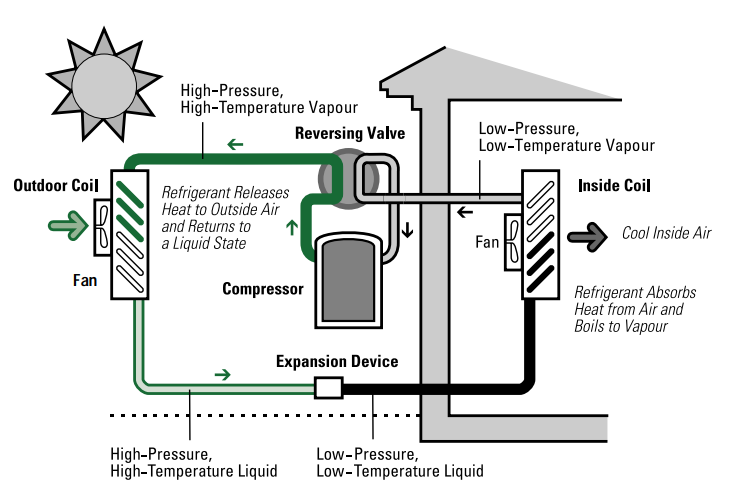When a Window Unit Isn’t Cool Enough
Bethany Davis Noll (Executive Director) / Jessica Bell (Energy Director & Deputy Director) / July 15, 2021

Recently, heat waves swept across the country, causing infrastructure damage and blackouts, as well as illness and deaths. Rising annual average temperatures mean that regions where people did not historically have air conditioners, like the Pacific Northwest, are reevaluating their home cooling options. This is a good time to look at the benefits of heat pumps for cooling and to reduce reliance on traditional oil and gas heating in the colder months.
Heat pumps move thermal (heat) energy from one place to another. While they do use energy, they can be powered by a grid that is being decarbonized and are more efficient than other heating types. Heat pumps save consumers money – through reducing the need for separate heating and cooling, lowering fuel costs, and increasing efficiency – and improve indoor air quality. And a recent study shows that replacing a gas furnace with a heat pump would reduce carbon emissions for 99 percent of households in the U.S.
Heat pumps can collect heat from air, the ground (geothermal), or water; air-source heat pumps are most commonly used for residential heating. Because heat naturally flows from high temperature areas to low temperature areas, on a steamy summer day, an air-source heat pump moves the heat from indoors through a set of coils and then a compressor to release heat from the system and cool the home.

The heating cycle is reversed to heat the home during the winter. Air-source heat pump technology has advanced to be a viable option even in colder regions. And if a homeowner still has an oil or gas furnace for additional heating that might be used on the coldest days, the amount of fuel used is reduced by having the heat pump as the primary heating source. For example, homeowners in rural Minnesota are installing heat pumps for cooling as well as spring and fall heat, drastically reducing their propane usage.
Earlier this spring, the Biden administration announced initiatives related to increasing adoption of heat pumps, including driving development of higher performing technologies and new ENERGY STAR standards. States and utilities have focused on getting heat pumps into homes, offering rebates and incentives to make heat pumps more affordable.
Existing programs often include a focus on ensuring that the efficiency gains, fuel cost savings, and other benefits of heat pumps are available to low-income populations. In 2019, Maine passed a bill that established a goal to install 100,000 heat pumps in the state by 2025. Reportedly, in early 2021, more than 60,000 heat pumps had been sold in the state over the prior seven years. The new program relies on Efficiency Maine Trust incentives funded by capacity auction revenues and the Low-Income House Energy Assistance Program. The trust provided $6.57 million in rebates for 11,701 heat pumps that year, and in 2020 Governor Janet Mills added new incentives.
As another example, in New York, NYSERDA offers several air-source heat pump incentives as well as ground source heat pump programs through its NYS Clean Heat Program, as well as low-interest loans to low-income residents for efficiency upgrades. In April 2021, NYS Clean Heat announced a new $10 million consumer education and awareness campaign to accelerate the adoption of heat pumps. The program is scheduled to run through 2025 and has a goal of driving at least 130,000 heat pump installations.
There are programs to promote the electrification of home heating across the country. In a 2020 survey, twenty-three responding programs reported serving nearly 24,000 customers in the prior year.
Electrification of home heating through heat pump technologies is an important tool that can be effective at meeting growing demand for air conditioning, as well as efficient, cleaner heating, even in cold climates. As explained in a recent statement by WE ACT for Environmental Justice, installation incentives and job creation should be the priority in low-income communities and communities of color, “which bear disproportionately higher energy and pollution burdens as well as disproportionately greater impacts from climate change.” Along with a focus on equity, weatherization, decarbonization, and work to address refrigerant concerns, heat pumps are sure to play a key role.
This page was updated on December 4, 2023 to better meet our accessibility standards. To see the page as it was initially published, click here.
